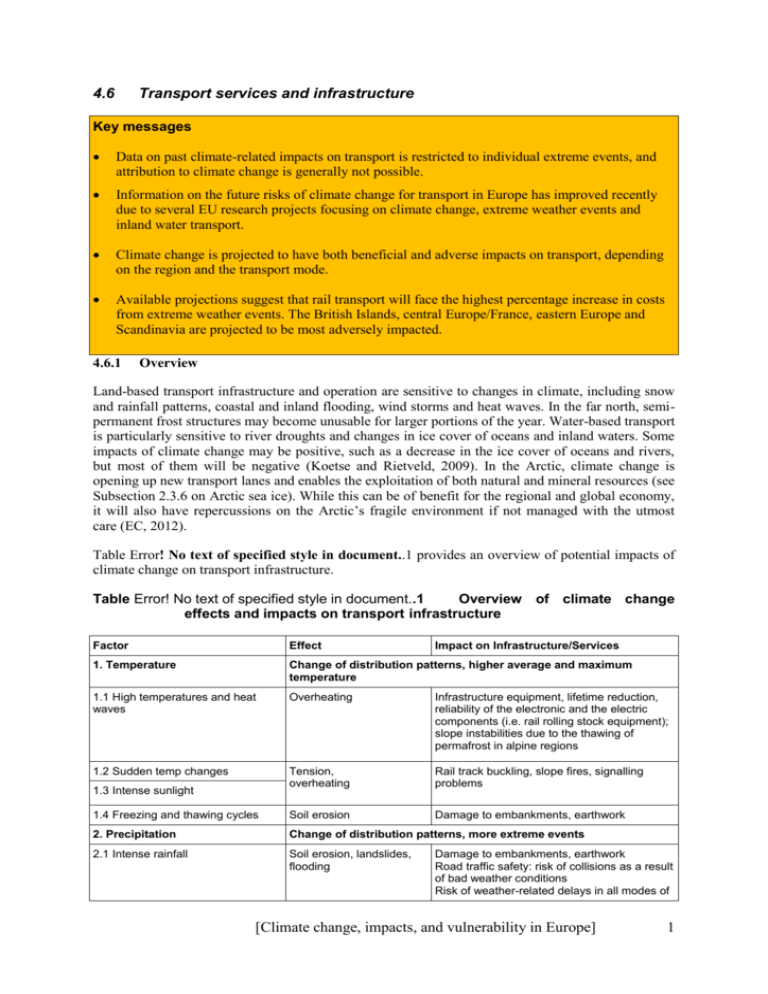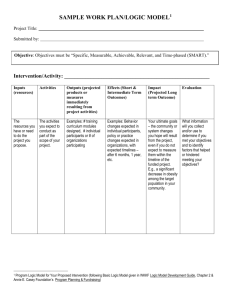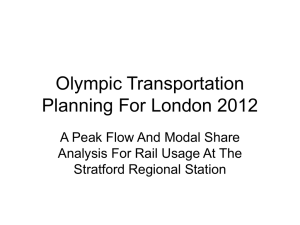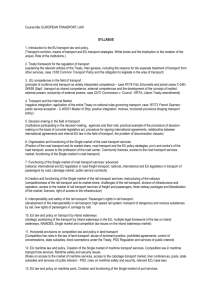4_6_Transport_revised_checked
advertisement

4.6 Transport services and infrastructure Key messages Data on past climate-related impacts on transport is restricted to individual extreme events, and attribution to climate change is generally not possible. Information on the future risks of climate change for transport in Europe has improved recently due to several EU research projects focusing on climate change, extreme weather events and inland water transport. Climate change is projected to have both beneficial and adverse impacts on transport, depending on the region and the transport mode. Available projections suggest that rail transport will face the highest percentage increase in costs from extreme weather events. The British Islands, central Europe/France, eastern Europe and Scandinavia are projected to be most adversely impacted. 4.6.1 Overview Land-based transport infrastructure and operation are sensitive to changes in climate, including snow and rainfall patterns, coastal and inland flooding, wind storms and heat waves. In the far north, semipermanent frost structures may become unusable for larger portions of the year. Water-based transport is particularly sensitive to river droughts and changes in ice cover of oceans and inland waters. Some impacts of climate change may be positive, such as a decrease in the ice cover of oceans and rivers, but most of them will be negative (Koetse and Rietveld, 2009). In the Arctic, climate change is opening up new transport lanes and enables the exploitation of both natural and mineral resources (see Subsection 2.3.6 on Arctic sea ice). While this can be of benefit for the regional and global economy, it will also have repercussions on the Arctic’s fragile environment if not managed with the utmost care (EC, 2012). Table Error! No text of specified style in document..1 provides an overview of potential impacts of climate change on transport infrastructure. Table Error! No text of specified style in document..1 Overview of climate change effects and impacts on transport infrastructure Factor Effect 1. Temperature Change of distribution patterns, higher average and maximum temperature 1.1 High temperatures and heat waves Overheating Infrastructure equipment, lifetime reduction, reliability of the electronic and the electric components (i.e. rail rolling stock equipment); slope instabilities due to the thawing of permafrost in alpine regions 1.2 Sudden temp changes Tension, overheating Rail track buckling, slope fires, signalling problems 1.4 Freezing and thawing cycles Soil erosion Damage to embankments, earthwork 2. Precipitation Change of distribution patterns, more extreme events 2.1 Intense rainfall Soil erosion, landslides, flooding 1.3 Intense sunlight Impact on Infrastructure/Services Damage to embankments, earthwork Road traffic safety: risk of collisions as a result of bad weather conditions Risk of weather-related delays in all modes of [Climate change, impacts, and vulnerability in Europe] 1 services 2.2 Extended rain periods Slower drainage, soil erosion 2.3 Flooding: coastal, surface water, fluvial Landslides Desiccation 2.4 Drought Rail infrastructure assets, operation Drainage systems, tunnels, increased scour of bridges Risk of weather-related delays in all modes of services Earthworks desiccation Road traffic safety: risk of collisions as a result of dust on road and consequent decrease of wheel grid Increased abrasion of mechanical components Potential change of water levels on navigable rivers (very low levels during summer and high levels in rain periods) 2.5 Snow and ice Heavy snowfall, avalanches Restrictions/disruption of train operations Road traffic safety: risk of collisions as a result of bad weather conditions Risk of weather-related delays in all modes of services 3. Wind Change of distribution patterns, more extreme events 3.1 Storm/gale (inland) Higher wind forces Damage to rail installations, catenary All modes potential traffic disruptions and safety concern Uprooting of trees Restrictions/disruption of train operation Road traffic safety 3.2 Coastal storms & sea-level rise Coastal flooding Embankments, earthwork, operation 4. Lightning strikes and thunderstorms Overvoltage Catenary, traffic control and communications systems 5. Vegetation Faster plant growth, new Vegetation management plants Source: Adapted from (Nolte et al., 2011) to incorporate main impacts on all modes of transport. Data on past climate-related impacts on transport are restricted to individual extreme events, and attribution to climate change is generally not possible. Some countries in Europe have assessed potential climate impacts on their transport infrastructure and/or adaptation options (e.g. the UK (UKCIP, 2011; Thornes et al., 2012), Spain (Crespo Garcia, 2011), Germany (Deutsche Bundesregierung, 2008) and Switzerland (BAFU, 2012). The level of detail in the analysis and the consideration of the potential risks and impacts on the different modes and on the transport sector as a whole differ considerably. The UK CCRA for the transport sector highlights extreme weather events as the main challenge for the maintenance and operation of existing infrastructure. The literature on potential economic impacts of climate change on transport infrastructure is still scarce but rapidly evolving. Most sector-specific studies on potential climate impacts and adaptation options focus on river transport (see Subsection 4.6.2) and on rail infrastructure (Nolte et al., 2011). Climate impacts on road transport can be both beneficial and adverse. Reduced snow and ice cover would improve traffic conditions, but increasing severity of storms would worsen them (see also Subsection 4.6.3). The remainder of this section presents results from three research projects 2 [Climate change, impacts, and vulnerability in Europe] addressing climate change impacts on transport that were funded under the Seventh Framework Programme for Research (FP7) of the European Commission. 4.6.2 Inland water transport The FP7 project ECCONET (1) assesses the impact of climate change on inland waterway transport (IWT) as well as possible adaptation measures. The project uses the Rhine–Main–Danube corridor as a case study with special emphasis on low water situations, which are most problematic for IWT. Over a period of 20 years, the average annual welfare loss due to low water levels on the Rhine was calculated at EUR 28 million; the 2003 extreme low-water year was associated with a welfare loss of EUR 91 million (Jonkeren et al., 2007). Other climate-related changes, such as high water levels, changed ice formation or a change in visibility due to fog, are assessed only briefly in ECCONET. Results based on projections from different climate models show no significant effects on low flow conditions for the Rhine canal and the Rhine–Main–Danube canal until 2050. The upper Danube would experience a moderate increase in low flow conditions. The trend towards drier summers and wetter winters will gain in importance towards the end of the 21st century. Disposition for ice formation on both the Rhine and Danube will most likely decrease over the whole 21st century (Nilson et al., 2012). Simulations with the NODUS transport model (Jonkeren et al., 2011) suggest that projected climate change until 2050 is unlikely to impact the Rhine hydrology strong enough to induce any significant shift in modal shares. The study estimates that a ‘dry’ year leads to approximately a 6–7 % increase in total transport cost compared to a ‘wet’ year, but these variations are already present under the current climate conditions and will not be influenced heavily by climate change until the 2050s. Low water levels could also trigger further impacts due to interruptions of coal supply to power stations (Rothstein and Halbig, 2010). 4.6.3 Impacts of changes in weather extremes Two FP7 projects assessed the impacts of climate change and extreme weather conditions on transport systems: WEATHER (2) and EWENT (3). The WEATHER project aimed at identifying risks, economic impacts, and suitable crises management and transport adaptation strategies for all modes of transport across Europe. The EWENT project looked more deeply into long-term weather scenarios and the sensitivities of transport modes by following a standard risk assessment process. Note that the definition of extremes strongly varies between approaches. In both projects it had to be acknowledged that there is a lag of reliable statistical data for a sound vulnerability assessment of transport modes in the European region. The WEATHER project considered the following extreme events: hot and cold spells, floods, landslides, wild fires and storms. Data were gathered through studies of various weather phenomena on transport in North America, Australia, Europe and New Zealand, a review of over 1 000 damage reports for 6 countries, and an assessment of available transport operator data for some European transport networks. The combined results have been extrapolated to eight European climate zones using meteorological indicators as well as infrastructure coverage and transport performance indicators. The standard cost values were considered specifically for public transport services, time 1 See http://www.ecconet.eu online. See http://www.weather-project.eu online. 3 See http://ewent.vtt.fi online. 2 [Climate change, impacts, and vulnerability in Europe] 3 losses and safety impacts for transport users. In addition, the assessment of indirect costs imposed by transport disruptions on other economic sectors was estimated. For the assessment period 1998 to 2010, the total costs borne by the transport sector (damages, repair and maintenance costs of infrastructures, vehicle damages, increased system operation costs, etc.) across all weather phenomena were estimated at EUR 2.5 billion per year. The indirect costs of transport disruptions on other sectors were estimated at EUR 1 billion per year. Rail is the most affected transport mode in relation to passenger and tonne kilometres, with hot spots in eastern Europe and Scandinavia largely caused by hydrological phenomena and their consequences. The effects on roads are more evenly distributed across Europe with somewhat higher costs in mountain areas and Scandinavia. The high vulnerability of road and rail infrastructure in mountain areas can be explained by the usually expensive infrastructures, while the high vulnerability of rail is due to the more complex reaction mechanisms in emergency cases. Projections for the period 2040–2050 (based on predictions of extremes taken from the EWENT project) suggest that rail will face the highest cost increase, with particular emphasis on the British Islands, central Europe and Scandinavia, mostly due to increases in hydrological extremes. The EWENT project assessed average annual costs due to weather extremes for the current (1998– 2010) and a future (2041–2070) time period. Costs comprise accident costs, time costs, infrastructure damage and maintenance, and effects on freight and logistics. EWENT estimates costs from extreme weather events in the baseline period of more than EUR 15 billion, which is dominated by the costs of road accidents. This estimate is more than four times above the estimates of direct and indirect costs from the WEATHER project. The main reasons for this difference are a wider definition of extreme events in EWENT, inclusion of externalities (accidents), and the explicit consideration of nonmotorised travel and logistics among other aspects, which were omitted by the WEATHER project. According to results from EWENT, different regions in Europe will respond to future changes in different ways. In Northern Europe, cold spells will become less frequent but the amount of snow (especially for the thresholds of deeper snow coverage) will increase. Continental climate in Eastern Europe will continue to warm up and this results in less cold spells and snow. Similar developments will be observed in Central Europe and the Alpine region. In the maritime region the main threat is the potential increase in strong winds. This will also be observed in the Mediterranean region, where also the heat waves are becoming more prolonged by 2050 (Leviäkangas et al., 2011; Vajda et al., 2011). Road transport is projected to experience beneficial and adverse impacts, with somewhat complex regional patterns. Rail transport experiences mostly negative impacts, with the exception of the Iberian Peninsula; the most severe impacts are projected for the British Isles and France. Aviation is projected to experience negative impacts throughout Europe. Negative impacts across all transport modes are projected for Scandinavia, the British Isles, France, and Eastern Europe. These projections are largely consistent with those of the WEATHER project discussed above. EWENT also assessed changes in the overall costs of extreme events on the transport sector. These costs are projected to decrease substantially in the future but this decrease is driven primarily by reduced costs of road accidents due to improved vehicle safety technologies. Follow-on costs on freight and logistics are expected to increase substantially but this increase is primarily driven by the projected increase in freight volumes. In summary, the costs of weather extremes on the transport sector are expected to be influenced more strongly by changes in technology and transport demand than by changes in weather extremes. The overall risks of extreme weather were assessed in EWENT for EU-27 Member States. A risk indicator based on probabilistic weather hazards and resilience and vulnerability of each Member State revealed that countries with poor quality infrastructures, dense traffic volumes and population, and low income levels are usually most at risk and will face the severest consequences (Molarius et al., 2012). 4 [Climate change, impacts, and vulnerability in Europe]









